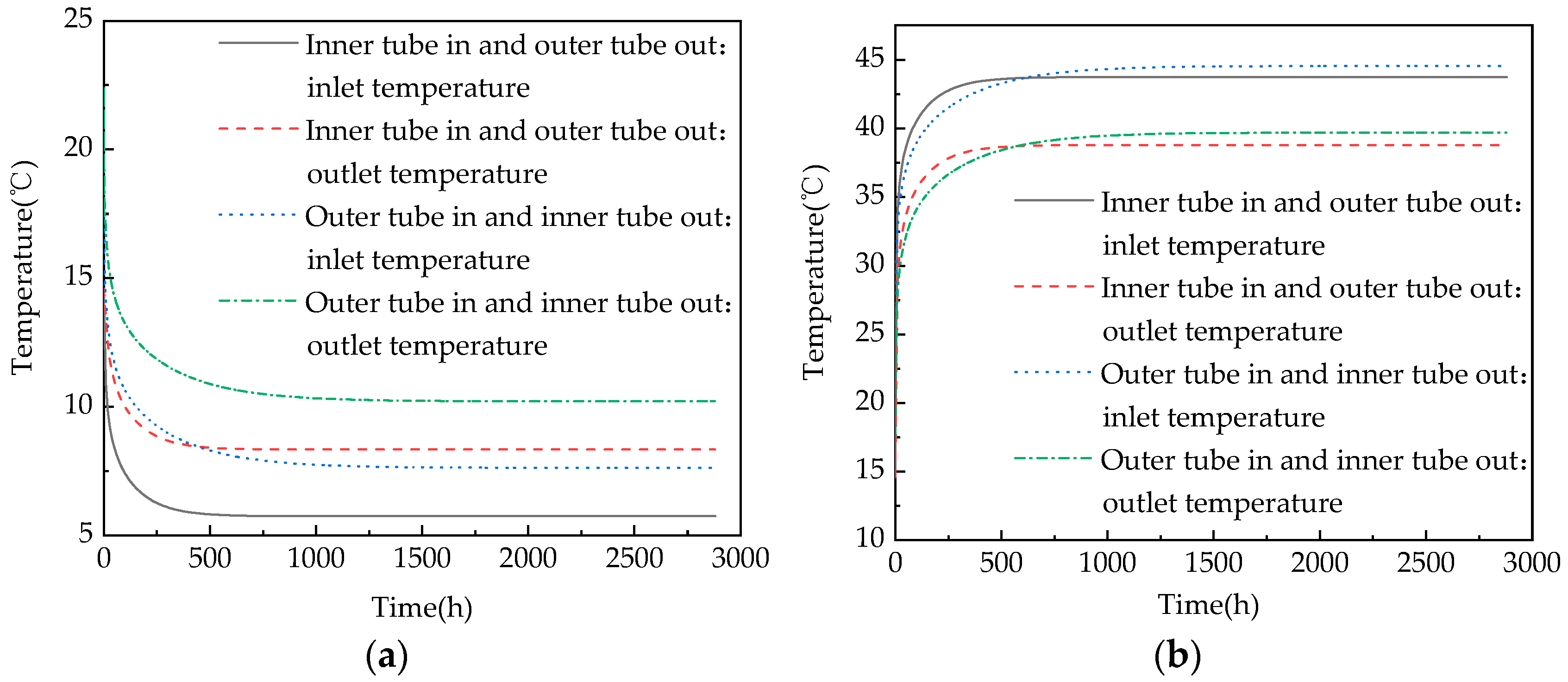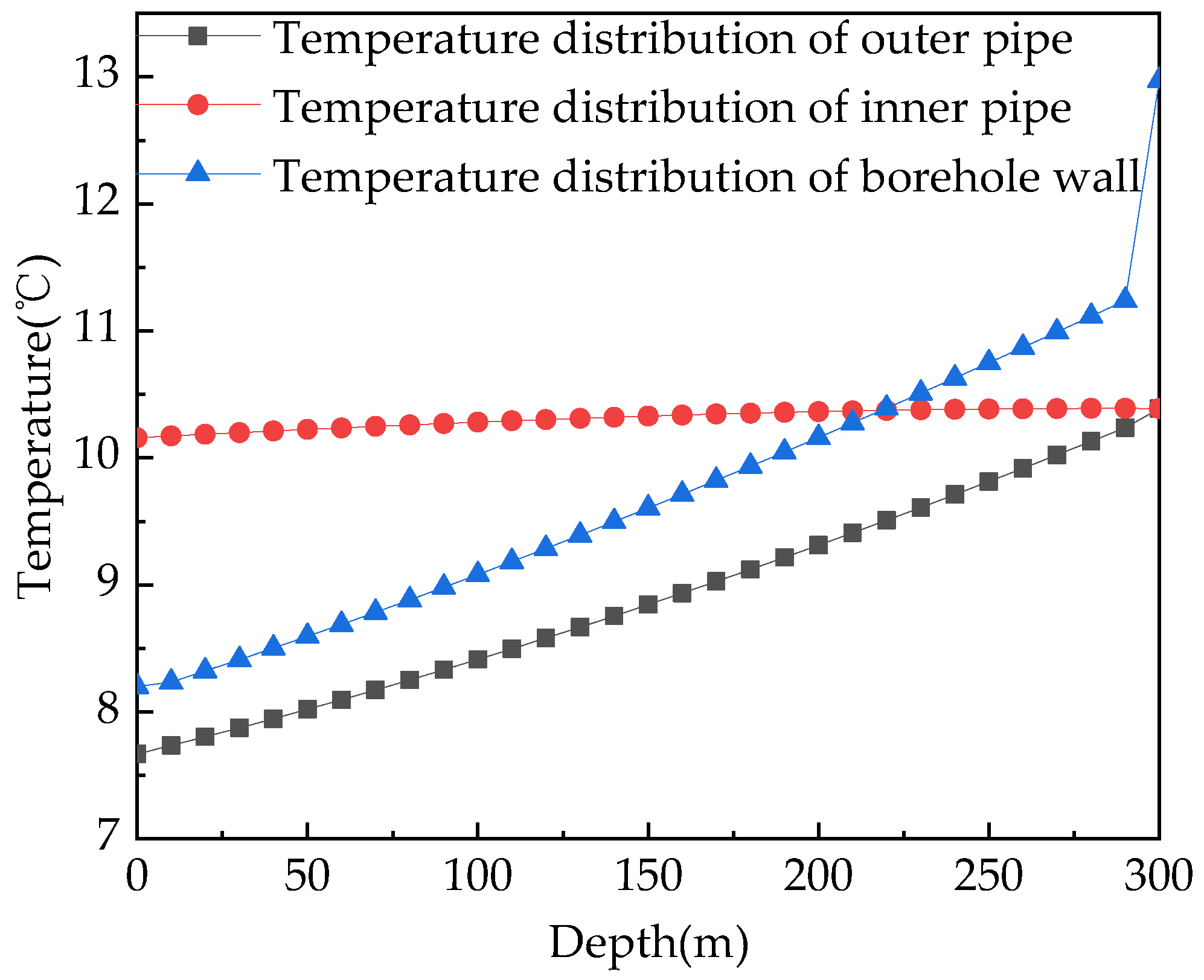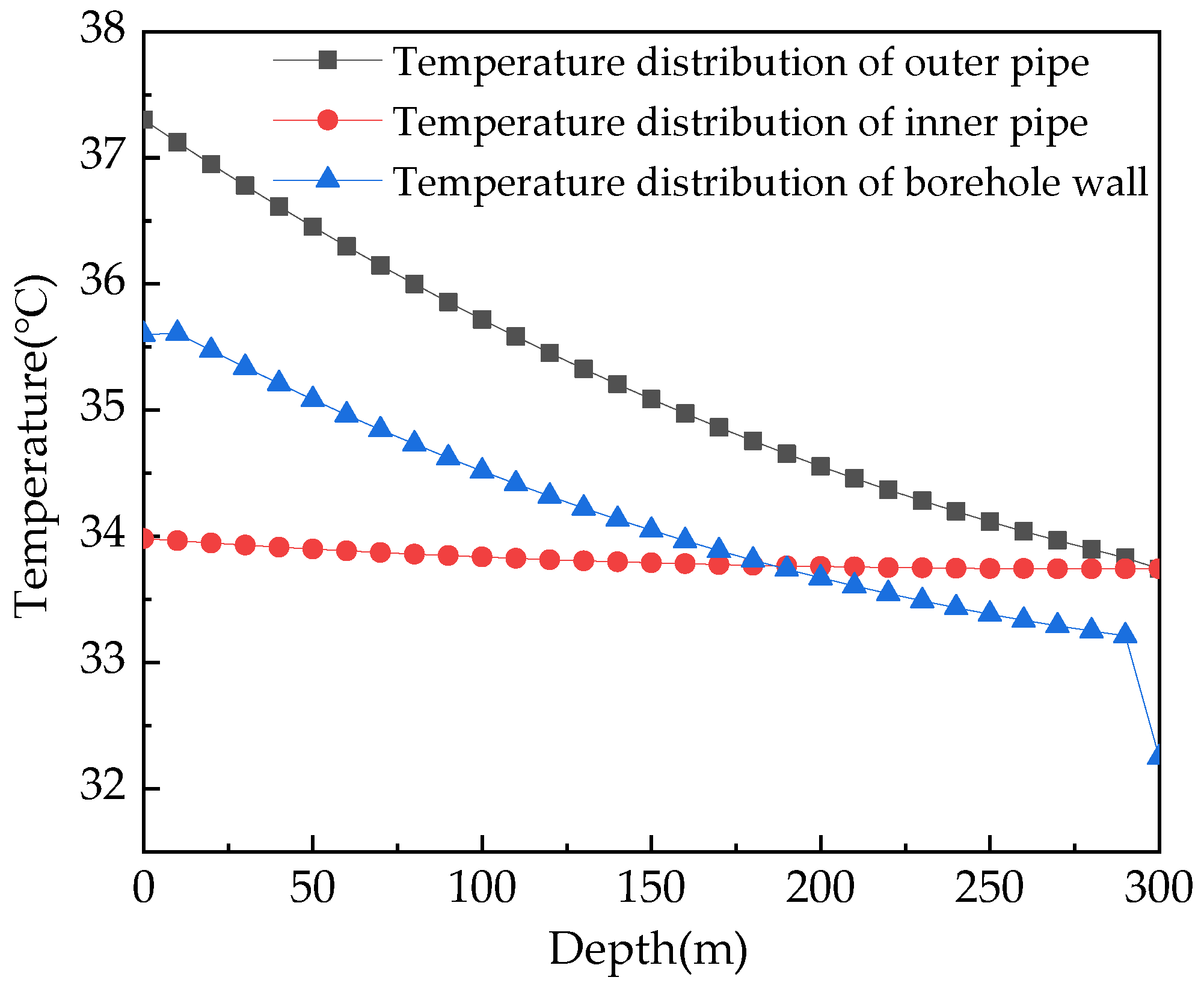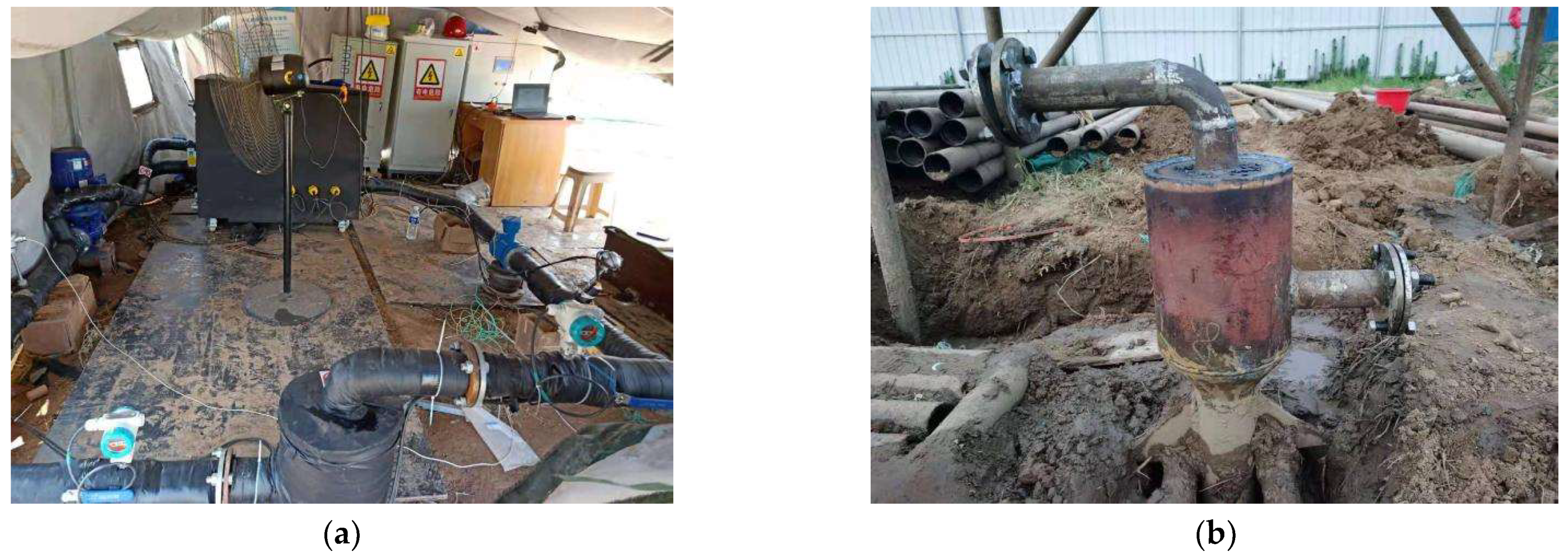Investigation of the Heat Transfer Performance of Multi-Borehole Double-Pipe Heat Exchangers in Medium-Shallow Strata
Abstract
:1. Introduction
2. Engineering Overview and Heat Transfer Model
2.1. Engineering Overview
2.2. Heat Transfer Model
2.2.1. Heat Transfer Model inside the Borehole
- (1)
- The energy equation for the “inner tube in and outer tube out” configuration can be expressed as:
- (2)
- The energy equation of the “outer tube in and inner tube out” configuration can be expressed as:
2.2.2. Heat Transfer Model outside the Borehole
- (1)
- The geotechnical layer around the borehole is parallel to the surface, and the thermal properties of the same layer are taken to be the same.
- (2)
- Due to the slow flow of water in the rock and soil, only the thermal conductivity is considered, and the seepage effect of water in the soil is ignored [17].
- (3)
- The radial boundary is far enough away to be an adiabatic boundary.
- (4)
- The earth’s heat flow is constant throughout the operation process.
2.2.3. Temperature Superposition
3. Simulation Analysis
3.1. Selection of Circulation Mode
3.2. Changes in Heat Exchange
3.3. Influence of the Geothermal Gradient on Heat Transfer
3.4. Temperature Change
3.4.1. Changes in the Inlet and Outlet Temperatures
3.4.2. Temperature Distribution of the Borehole Wall and the Inner and Outer Pipe’s Circulating Liquid
4. Comparative Analysis of the Experimental Data and Theoretical Calculation
4.1. Experimental Test
4.2. Comparison of the Inlet and Outlet Temperatures
4.3. Comparison of the Heat Exchange
5. Conclusions
- (1)
- Comparing the inlet and outlet temperatures of the circulating liquid in different flow directions, when the heat exchanger continuously takes heat throughout the winter and continuously releases heat in the summer, the “outer tube in and inner tube out” circulation method is more conducive to the implementation of the project.
- (2)
- When comparing the heat exchange between single-hole, double-hole and four-hole configurations, whether in winter or summer, the heat exchange of the heat exchanger increases with increasing drilling distance and decreases as the number of drilled holes increases. Through comparison, the most suitable spacing is concluded to be 3 m when the project is implemented with a multiple-hole system.
- (3)
- A temperature gradient is more conducive to heat exchange. At the same time, the greater the number of boreholes, the stronger the interference between the boreholes, and the more obvious the temperature change at the inlet and outlet.
- (4)
- After the operation is completed in either winter or summer, the temperature of the borehole wall and the temperature of the inner and outer pipes will increase or decrease to varying degrees with the increase in the depth of the borehole; the more obvious the temperature changes of the circulating fluid in the inner and outer pipes, the more the pipe wall temperature is replaced and the better the thermal performance; finally, the change in the borehole wall temperature indirectly reflects the change in the temperature of the rock and soil layer with depth. The greater the temperature change of the borehole wall, the better the heat transfer performance of the rock and soil layer.
- (5)
- When comparing the simulated data with the experimental data, the error is small whether for the inlet and outlet temperature or the heat exchange, which verifies the applicability of the heat transfer model.
Author Contributions
Funding
Acknowledgments
Conflicts of Interest
References
- Kong, Y.; Chen, C.; Shao, H.; Pang, Z.; Xiong, L.; Wang, J. Principle and capacity quantification of deep-borehole heat exchangers. Chin. J. Geophys. 2017, 60, 4741–4752. [Google Scholar]
- Luo, N.; Ren, X. Geothermal energy heating and cooling technology and application. Clean. World 2021, 37, 99–100. [Google Scholar]
- Hu, Y. The direct utilization of medium and shallow geothermal energy in China has ranked first in the world for many years. Pet. Refin. Eng. 2019, 49, 6. [Google Scholar]
- Guo, X.; Li, X. Study on current situation and development countermeasures of geothermal energy direct Utilization industry in China. Sol. Energy 2016, 17–20. [Google Scholar] [CrossRef]
- Shen, H. Present situation and development trend of geothermal energy exploitation and utilization in China. Sci. Technol. Innov. 2019, 20–21. [Google Scholar] [CrossRef]
- Renaud, T.; Verdin, P.; Falcone, G. Numerical simulation of a Deep Borehole Heat Exchanger in the Krafla geothermal system. Int. J. Heat Mass Transf. 2019, 143, 118496. [Google Scholar] [CrossRef]
- Li, J.; Xu, W.; Li, J.; Huang, S.; Li, Z.; Qiao, B.; Yang, C.; Sun, D.; Zhang, G. Heat extraction model and characteristics of coaxial deep borehole heat exchanger. Renew. Energy 2021, 169, 738. [Google Scholar] [CrossRef]
- Fang, L.; Diao, N.; Shao, Z.; Zhu, K.; Fang, Z. A computationally efficient numerical model for heat transfer simulation of deep borehole heat exchangers. Energy Build. 2018, 167, 79–88. [Google Scholar] [CrossRef]
- Cai, W.; Wang, F.; Chen, S.; Chen, C.; Liu, J.; Deng, J.; Kolditz, O.; Shao, H. Analysis of heat extraction performance and long-term sustainability for multiple deep borehole heat exchanger array: A project-based study. Appl. Energy 2021, 289, 116590. [Google Scholar] [CrossRef]
- Du, T.; Man, Y.; Jiang, G.; Li, S.; Zhang, X. Simulation Study on Optimal Drilling Spacing of Medium and Deep Buried Tube Heat Exchanger. Gas Heat 2019, 39, 21–24. [Google Scholar]
- Jia, L. Analytical Solution and Heat Transfer Analysis of Medium and Deep Buried Tube Heat Exchangers. Master’s Thesis, Shandong Jianzhu University, Jinan, China, 2021. [Google Scholar]
- Tang, X.; Cheng, L.; Xu, W.; Tingting, K.; Ying, D.; Jiasheng, T. Numerical study on factors that influence the heat transfer performance of mid-deep coaxial casing heat exchanger in the Xi’an area. Chin. J. Geol. 2021, 56, 985. [Google Scholar] [CrossRef]
- Zhang, F.; Fang, L.; Jia, L.; Man, Y.; Cui, P.; Zhang, W.; Fang, Z. A Dimension Reduction Algorithm for Numerical Simulation of Multi-Borehole Heat Exchangers. Renew. Energy 2021, 179, 2235–2245. [Google Scholar] [CrossRef]
- Jing, C. Study on geothermal geological characteristics and Exploitation and utilization in the eastern Plain of Handan. Master’s Thesis, China University of Geosciences, Wuhan, China, 2007. [Google Scholar]
- Dou, H.; Chen, X.; Xin, S.; Wang, H.; Zhou, Q. Experimental study on exploitation and irrigation of sandstone heat reservoir in Guantao Formation, Jizhong. Geotech. Investig. Surv. 2022, 50, 35–42. [Google Scholar]
- Zhang, Z.; Wu, X.; Zhao, J. Summary and suggestions of related standards and specificat- ons of ground source heat pumps and their systems. Sol. Energy 2015, 8–11+19. [Google Scholar] [CrossRef]
- Piechowski, M. Heat and mass transfer model of a ground heat exchanger: Validation and sensitivity analysis. Int. J. Energy Res. 1998, 22, 965. [Google Scholar] [CrossRef]
- Man, Y.; Jiang, G.; Du, T.; Fang, L.; Fang, Z. Modeling of deep and middle geothermal energy utilization in abandoned oil wells. Joural Shandong Jianzhu Univ. 2019, 34, 20. [Google Scholar] [CrossRef]
- Beier, R.A. Thermal response tests on deep borehole heat exchangers with geothermal gradient. Appl. Therm. Eng. 2020, 178, 115447. [Google Scholar] [CrossRef]
- Guan, C.; Zhao, S.; Zhang, W.; Sun, B.; Wang, J.; Sun, Z.; Fang, Z. Heat transfer analysis of ground heat exchangers for medium-deep geothermal energy heating. HV AC 2021, 51, 107–112. [Google Scholar]














| Parameter | Symbol | Unit | Numerical Value |
|---|---|---|---|
| Drilling depth | H | m | 300 |
| Geotechnical thermal conductivity | λp3 | W/(m·K) | 2.09 |
| Volumetric specific heat capacity of geotechnical layer | (ρc)3 | J/(m3·K) | 2.46 × 106 |
| Drilling diameter | db | m | 0.133 |
| Outer tube outer diameter | d20 | m | 0.108 |
| Outer tube inner diameter | d2i | m | 0.099 |
| Inner tube outer diameter | d10 | m | 0.063 |
| Inner tube inner diameter | d1i | m | 0.0526 |
| Thermal conductivity of inner tube | λp1 | W/(m·K) | 0.24 |
| Thermal conductivity of outer tube | λp2 | W/(m·K) | 45 |
| Thermal conductivity of backfill material | λg | W/(m·K) | 1.83 |
| Volume specific heat capacity of circulating liquid | ρc | J/(m3·K) | 4.187 × 106 |
| Volume specific heat capacity of inner tube | (ρc)1 | J/(m3·K) | 1.9 × 106 |
| Volume specific heat capacity of outer tube | (ρc)2 | J/(m3·K) | 3.45 × 106 |
| Volume specific heat capacity of backfill material | (ρc)g | J/(m3·K) | 2.42 × 106 |
| Annual mean temperature of the atmosphere (surface temperature) | Ta | °C | 14.6 |
| Surface convective heat transfer coefficient | Ha | W/(m2·K) | 15 |
| Heat flow | qg | W/m2 | 0.065 |
Publisher’s Note: MDPI stays neutral with regard to jurisdictional claims in published maps and institutional affiliations. |
© 2022 by the authors. Licensee MDPI, Basel, Switzerland. This article is an open access article distributed under the terms and conditions of the Creative Commons Attribution (CC BY) license (https://creativecommons.org/licenses/by/4.0/).
Share and Cite
Li, W.; Zhang, W.; Li, Z.; Yao, H.; Cui, P.; Zhang, F. Investigation of the Heat Transfer Performance of Multi-Borehole Double-Pipe Heat Exchangers in Medium-Shallow Strata. Energies 2022, 15, 4798. https://doi.org/10.3390/en15134798
Li W, Zhang W, Li Z, Yao H, Cui P, Zhang F. Investigation of the Heat Transfer Performance of Multi-Borehole Double-Pipe Heat Exchangers in Medium-Shallow Strata. Energies. 2022; 15(13):4798. https://doi.org/10.3390/en15134798
Chicago/Turabian StyleLi, Wenjing, Wenke Zhang, Zhenxing Li, Haiqing Yao, Ping Cui, and Fangfang Zhang. 2022. "Investigation of the Heat Transfer Performance of Multi-Borehole Double-Pipe Heat Exchangers in Medium-Shallow Strata" Energies 15, no. 13: 4798. https://doi.org/10.3390/en15134798





